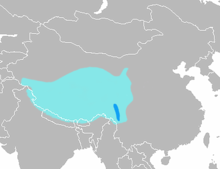| Bharal | |
|---|---|

| |
| Male bharal in Spiti Valley | |

| |
| Female bharal in North Sikkim | |
| Scientific classification | |
| Domain: | Eukaryota |
| Kingdom: | Animalia |
| Phylum: | Chordata |
| Class: | Mammalia |
| Order: | Artiodactyla |
| Family: | Bovidae |
| Subfamily: | Caprinae |
| Tribe: | Caprini |
| Genus: | Pseudois Hodgson, 1846 |
| Species: | P. nayaur
|
| Binomial name | |
| Pseudois nayaur (Hodgson, 1833)
| |

| |
| Distribution of blue sheep; dwarf blue sheep range in darker blue | |
| Synonyms | |
|
Pseudois schaeferi Haltenorth, 1963 Pseudois nayaur schaeferi | |
The bharal (Pseudois nayaur), also called the blue sheep, is a caprine native to the high Himalayas. It is the only member of the genus Pseudois.[3] It occurs in India, Bhutan, China (in Gansu, Ningxia, Sichuan, Tibet, and Inner Mongolia), Myanmar, Nepal, and Pakistan.[1] The Helan Mountains of Ningxia have the highest concentration of bharal in the world, with 15 bharals per km2 and 30,000 in total.
Its native names include yanyang (岩羊) in Mandarin, bharal, barhal, bharar, and bharut in Hindi, na or sna in Tibetan and Ladakh, nabo in Spitian, naur in Nepali and na or gnao in Bhutan.[4] The bharal was also the focus of George Schaller and Peter Matthiessen's expedition to Nepal in 1973. Their personal experiences are well documented by Matthiessen in his book, The Snow Leopard. The bharal is a major prey of the snow leopard.
- ^ a b Harris, R.B. (2014). "Pseudois nayaur". IUCN Red List of Threatened Species. 2014: e.T61513537A64313015. doi:10.2305/IUCN.UK.2014-3.RLTS.T61513537A64313015.en. Retrieved 19 November 2021.
- ^ Wang, X.M.; Hoffmann, R.S. (1987). "Pseudois nayaur and Pseudois schaeferi". Mammalian Species (278): 1–6. doi:10.2307/3503993. JSTOR 3503993.
- ^ "Pseudois nayaur (Hodgson, 1833)". ASM Mammal Diversity Database. American Society of Mammalogists. Retrieved 2021-08-28.
- ^ Lydekker, R. (1900). The great and small game of India, Burma and Tibet, p 93,
